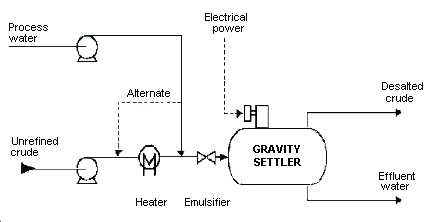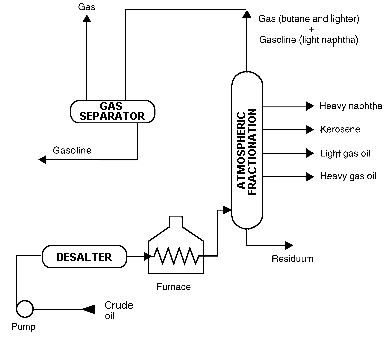Description of Petroleum Refining Processes and Related Health and Safety Considerations
Crude Oil Pretreatment (Desalting)
- Description
- Crude oil often contains water, inorganic salts, suspended solids, and water-soluble trace metals. As a first step in the refining process, to reduce corrosion, plugging, and fouling of equipment and to prevent poisoning the catalysts in processing units, these contaminants must be removed by desalting (dehydration).
- The two most typical methods of crude-oil desalting, chemical and electrostatic separation, use hot water as the extraction agent. In chemical desalting, water and chemical surfactant (demulsifiers) are added to the crude, heated so that salts and other impurities dissolve into the water or attach to the water, and then held in a tank where they settle out. Electrical desalting is the application of high-voltage electrostatic charges to concentrate suspended water globules in the bottom of the settling tank. Surfactants are added only when the crude has a large amount of suspended solids. Both methods of desalting are continuous. A third and less-common process involves filtering heated crude using diatomaceous earth.
- The feedstock crude oil is heated to between 150° and 350°F to reduce viscosity and surface tension for easier mixing and separation of the water. The temperature is limited by the vapor pressure of the crude-oil feedstock. In both methods other chemicals may be added. Ammonia is often used to reduce corrosion. Caustic or acid may be added to adjust the pH of the water wash. Wastewater and contaminants are discharged from the bottom of the settling tank to the wastewater treatment facility. The desalted crude is continuously drawn from the top of the settling tanks and sent to the crude distillation (fractionating) tower.

- Health and Safety Considerations
- Fire Prevention and Protection. The potential exists for a fire due to a leak or release of crude from heaters in the crude desalting unit. Low boiling point components of crude may also be released if a leak occurs.
- Safety. Inadequate desalting can cause fouling of heater tubes and heat exchangers throughout the refinery. Fouling restricts product flow and heat transfer and leads to failures due to increased pressures and temperatures. Corrosion, which occurs due to the presence of hydrogen sulfide, hydrogen chloride, naphthenic (organic) acids, and other contaminants in the crude oil, also causes equipment failure. Neutralized salts (ammonium chlorides and sulfides), when moistened by condensed water, can cause corrosion. Overpressuring the unit is another potential hazard that causes failures.
- Health. Because this is a closed process, there is little potential for exposure to crude oil unless a leak or release occurs. Where elevated operating temperatures are used when desalting sour crudes, hydrogen sulfide will be present. There is the possibility of exposure to ammonia, dry chemical demulsifiers, caustics, and/or acids during this operation. Safe work practices and/or the use of appropriate personal protective equipment may be needed for exposures to chemicals and other hazards such as heat, and during process sampling, inspection, maintenance, and turnaround activities.
Depending on the crude feedstock and the treatment chemicals used, the wastewater will contain varying amounts of chlorides, sulfides, bicarbonates, ammonia, hydrocarbons, phenol, and suspended solids. If diatomaceous earth is used in filtration, exposures should be minimized or controlled. Diatomaceous earth can contain silica in very fine particle size, making this a potential respiratory hazard.
- Crude Oil Distillation (Fractionation)
- Description. The first step in the refining process is the separation of crude oil into various fractions or straight-run cuts by distillation in atmospheric and vacuum towers. The main fractions or "cuts" obtained have specific boiling-point ranges and can be classified in order of decreasing volatility into gases, light distillates, middle distillates, gas oils, and residuum.
- Atmospheric Distillation Tower
- At the refinery, the desalted crude feedstock is preheated using recovered process heat. The feedstock then flows to a direct-fired crude charge heater where it is fed into the vertical distillation column just above the bottom, at pressures slightly above atmospheric and at temperatures ranging from 650° to 700° F (heating crude oil above these temperatures may cause undesirable thermal cracking). All but the heaviest fractions flash into vapor. As the hot vapor rises in the tower, its temperature is reduced. Heavy fuel oil or asphalt residue is taken from the bottom. At successively higher points on the tower, the various major products including lubricating oil, heating oil, kerosene, gasoline, and uncondensed gases (which condense at lower temperatures) are drawn off.
- The fractionating tower, a steel cylinder about 120 feet high, contains horizontal steel trays for separating and collecting the liquids. At each tray, vapors from below enter perforations and bubble caps. They permit the vapors to bubble through the liquid on the tray, causing some condensation at the temperature of that tray. An overflow pipe drains the condensed liquids from each tray back to the tray below, where the higher temperature causes re-evaporation. The evaporation, condensing, and scrubbing operation is repeated many times until the desired degree of product purity is reached. Then side streams from certain trays are taken off to obtain the desired fractions. Products ranging from uncondensed fixed gases at the top to heavy fuel oils at the bottom can be taken continuously from a fractionating tower. Steam is often used in towers to lower the vapor pressure and create a partial vacuum. The distillation process separates the major constituents of crude oil into so-called straight-run products. Sometimes crude oil is "topped" by distilling off only the lighter fractions, leaving a heavy residue that is often distilled further under high vacuum.

Distillation Tower. In order to further distill the residuum or topped crude from the atmospheric tower at higher temperatures, reduced pressure is required to prevent thermal cracking. The process takes place in one or more vacuum distillation towers. The principles of vacuum distillation resemble those of fractional distillation and, except that larger-diameter columns are used to maintain comparable vapor velocities at the reduced pressures, the equipment is also similar. The internal designs of some vacuum towers are different from atmospheric towers in that random packing and demister pads are used instead of trays. A typical first-phase vacuum tower may produce gas oils, lubricating-oil base stocks, and heavy residual for propane deasphalting. A second-phase tower operating at lower vacuum may distill surplus residuum from the atmospheric tower, which is not used for lube-stock processing, and surplus residuum from the first vacuum tower not used for deasphalting. Vacuum towers are typically used to separate catalytic cracking feedstock from surplus residuum.
- Other Distillation Towers (Columns). Within refineries there are numerous other, smaller distillation towers called columns, designed to separate specific and unique products. Columns all work on the same principles as the towers described above. For example, a depropanizer is a small column designed to separate propane and lighter gases from butane and heavier components. Another larger column is used to separate ethyl benzene and xylene. Small "bubble" towers called strippers use steam to remove trace amounts of light products from heavier product streams.
- Health and Safety Considerations
- Fire Prevention and Protection. Even though these are closed processes, heaters and exchangers in the atmospheric and vacuum distillation units could provide a source of ignition, and the potential for a fire exists should a leak or release occur.
- Safety. An excursion in pressure, temperature, or liquid levels may occur if automatic control devices fail. Control of temperature, pressure, and reflux within operating parameters is needed to prevent thermal cracking within the distillation towers. Relief systems should be provided for overpressure and operations monitored to prevent crude from entering the reformer charge.
The sections of the process susceptible to corrosion include (but may not be limited to) preheat exchanger (HCl and H2S), preheat furnace and bottoms exchanger (H2S and sulfur compounds), atmospheric tower and vacuum furnace (H2S, sulfur compounds, and organic acids), vacuum tower (H2S and organic acids), and overhead (H2S, HCl, and water). Where sour crudes are processed, severe corrosion can occur in furnace tubing and in both atmospheric and vacuum towers where metal temperatures exceed 450° F. Wet H2S also will cause cracks in steel. When processing high-nitrogen crudes, nitrogen oxides can form in the flue gases of furnaces. Nitrogen oxides are corrosive to steel when cooled to low temperatures in the presence of water.
Chemicals are used to control corrosion by hydrochloric acid produced in distillation units. Ammonia may be injected into the overhead stream prior to initial condensation and/or an alkaline solution may be carefully injected into the hot crude-oil feed. If sufficient wash-water is not injected, deposits of ammonium chloride can form and cause serious corrosion. Crude feedstock may contain appreciable amounts of water in suspension which can separate during startup and, along with water remaining in the tower from steam purging, settle in the bottom of the tower. This water can be heated to the boiling point and create an instantaneous vaporization explosion upon contact with the oil in the unit.
- Health. Atmospheric and vacuum distillation are closed processes and exposures are expected to be minimal. When sour (high-sulfur) crudes are processed, there is potential for exposure to hydrogen sulfide in the preheat exchanger and furnace, tower flash zone and overhead system, vacuum furnace and tower, and bottoms exchanger. Hydrogen chloride may be present in the preheat exchanger, tower top zones, and overheads. Wastewater may contain water-soluble sulfides in high concentrations and other water-soluble compounds such as ammonia, chlorides, phenol, mercaptans, etc., depending upon the crude feedstock and the treatment chemicals. Safe work practices and/or the use of appropriate personal protective equipment may be needed for exposures to chemicals and other hazards such as heat and noise, and during sampling, inspection, maintenance, and turnaround activities.






